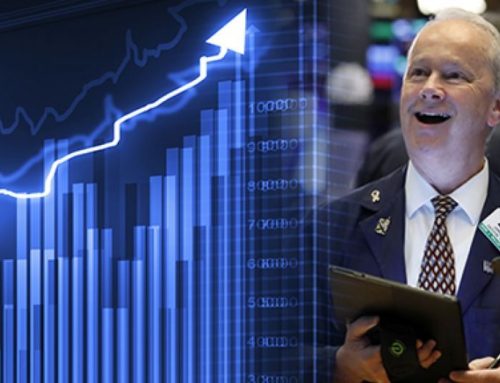Headwinds turn into Tailwinds
 Stocks break their downtrend…
Stocks break their downtrend…
Stocks started out the week continuing their downtrend into Wednesday. Worries about the trade deal with China seemed to be escalating while Turkey was set to invade Syria leaving the U.S. friendly Kurd population at risk and impeachment talks continued to gain momentum with Giuliani now under investigation for Ukraine deals.
A cease-fire, so to speak, seemed to be reached between President Trump and Chinese Vice Premier Liu He by Friday. China agreed to buy more U.S. farm goods, while the U.S. will hold off on placing new tariffs in place on October 15th. Trump called this “phase one” with “phase two” talks to begin immediately.
The Dow responded with a bang running up 517 points before pulling back to close up almost 320 points on the day. For the full week, the Dow rallied 242 points or 0.9% finishing at 26,816. The S&P advanced 0.6% ending the week at 2970 while the Nasdaq ran up 0.9% closing at 8057. All three snapped their 3-week losing streak.
S&P 3300 ahead…
Lance Roberts, author of the RealInvestmentAdvice blog, outlined a case for the S&P to rally up to 3300 in a ZeroHedge article. The real thorny issues with China have yet to be resolved so the recent trade “deal” is really not a complete package but will be spun by the Trump administration as a true “win”. The Fed lowered rates and is expected to do so again at the next meeting fueling liquidity hopes. A pathway to Brexit seems to be emerging and both the Fed and the ECB (European Central Bank) are loosening capital requirements for the banks. This all adds up to a “risk on” environment which can fuel a rally breaking the 3000 level which has contained the S&P so far.
Retail investors are typically considered a contrarian signal as they buy high and sell low overall. They have been fleeing the market in droves acting as though a financial crisis is around the corner. Bank of America reported that individual investors have not been this bearish since the collapse of Lehman Brothers in 2008. BAC measured money market inflows and $322 billion has flowed into cash over the past six months from retail investors. This is the largest level of inflows since the second half of 2008.
BAC’s chief investment officer, Michael Harnett, believes this is “bearish paralysis” brought on by concerns over Brexit, impeachment progress, trade wars and recession fears. For the week ending October 9th, investors added another $9.8 billion to money markets according to EPFR.
While retail investors are often considered contrarian indicators, insiders are looked to as savvy investors. Insiders are dumping stocks at the fastest rate since 2000 according to a ZeroHedge article. Insiders have sold $26 billion in 2019 compared to sales of $37 billion in 2000 prior to the start of the dot-com bubble bursting.
Stock buybacks continue as cumulatively they are up 20% YOY from 2018 which had set a record for buybacks. The IPO market has turned the corner as the latest crew have fallen dramatically from their issue prices. While this is a very different market than the flood of dot-com stocks which fueled IPO’s in 2000, the similarity is the number of stocks burning through cash at alarming rates.
Uber lost $3.3 billion last year while its competitor, Lyft burned through $900 million. Peleton, Beyond Meat and Slack have yet to turn a profit and forecasts for breakeven are years away for most of these stocks. WeWorks is the talk of the town as the IPO was pulled which also cut off the $6 billion in loans from JPMorgan dependent on the stock going public. While the board kicked their founder to the curb and is furiously cutting staff, selling the $60 billion corporate jet which Neumann purchased just last year and other cost-cutting measures, there is concern over the viability of the company.
Stocks now outpace bonds…
Stocks have once again overtaken bonds for the year. The SPDR S&P 500 exchange-traded fund (SPY) was up 18.5% for the year as of Friday’s close. The ishares 20+ Treasury Bond EFT (TLT) is now up 15.6%. This is a change from this past July, when TLT was leading SPY by 20% to 8% according to Barron’s. Investors have poured $379 billion into bond funds while selling $217 billion from equity funds so far this year, according to Bank of American Merrill Lynch. This trend continued with sales of equities totaling $9.8 billion while investors added $11.1 billion to bond funds for the week ending October 9th.
Bond prices rise when yields fall. If the Fed does indeed resume their QE and roll out version 4.0, then bonds may indeed rally. However, rates can rise due to many other factors and bonds may not offer the safety or negative correlation to stocks in the near future.
The Fed does seem ready to launch QE4 as it was disclosed this weekend that the Fed held a secret video meeting on October 4th. They plan to begin buying up $60 billion of T-bills per month which may last into Q2 of 2020. The recent repo issue may have something to do with this as the Fed added over $100 billion in overnight liquidity to keep markets steady.
DeNederlandsche Bank or DNB which is the Dutch Central Bank, startled Wall Street with a pronouncement that “if the entire system collapses, the gold stock provides collateral to start over”. Gold has rallied from the $1200 level in December 2018 to a recent high of $1550. It has pulled back into the $1480 level and may fall a bit further if the markets rally. Gold can provide both an inflation hedge as well as an asset seen as “safe” if the markets take a big hit. You might consider adding gold to your portfolios as an alternative to stocks and bonds on a further pullback.
Be prudent about your portfolio and as always, feel free to reach out for a second opinion.





Leave A Comment